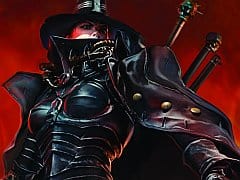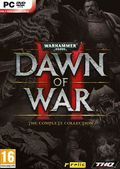You can trust VideoGamer. Our team of gaming experts spend hours testing and reviewing the latest games, to ensure you're reading the most comprehensive guide possible. Rest assured, all imagery and advice is unique and original. Check out how we test and review games here
Sub-Sector Aurelia is on the brink of annihilation. Again. After enough bother to fill two games, The Emperor has sent a powerful intergalactic armada to perform Exterminatus on the region and start afresh, wiping the slate clean by snuffing out millions of residents – basically an intergalactic version of getting rid of some kitchen mould with a satchel of C4. Meanwhile, I’m stomping gitz in a bid to get my green hands on a nice new hat.
I picked the Orks, basically. Who wouldn’t? Retribution might have six playable races – Space Marine, Tyranid, Eldar, Imperial Guard, Ork and Chaos – available for a third helping of Relic’s endearing RTS-meets-RPG campaign, but you’re absolutely dead inside if your mouse pointer doesn’t naturally gravitate towards Ork pirate Kaptin Bluddflagg and his merry band of ork boyz. He’s got a hat and everything.
But who am I to judge? You might fancy the minty freshness of the Imperial Guard, a contingent of cannon fodder making their first playable appearance in Dawn of War II. They come complete with their requisite quotas of stiff upper lips, masses of infantry, and immaculately groomed moustaches. Maybe it’s that you remember painting an army of flimsy Eldar as a child, swarming foes as the Tyranids, or you just enjoy the idea of pledging allegiance to one of the Chaos gods – bestowing unit buffs from shrines erected in their honour. You might, possibly, even like playing as the Space Marines.
Whichever faction you opt for, the real new notch in Retribution’s sturdy belt is an abundance of versatility. Dawn of War II and Chaos Rising funnelled you through tight, scripted campaigns as the same quartet of Space Marine hero units, over and over again. It was the same excellent confrontational template repeated until the end credits: set up your heavy weapons guy behind a patch of cover, jump your jetpack-toting assault marines into the middle of the conflict, and mop everything else up with your Force Commander and his massive hammer.
New additions further shake up the basic mechanics beyond the well-worn pattern of former titles. Retribution now gives the ability to bolster your ranks by purchasing further units to fight alongside your heroes, meaning you’re often fielding an entire army as opposed to a single squad. There’s even an old-school population cap in place. The overall result is an experience more similar to what you’d expect from a traditional RTS.
This is plainly apparent as the Imperial Guard. Take shady Commissar Lord Bernn, whose primary Execute ability allows him to dispatch an allied troop in a bid to get everyone else to resist enemy suppression and fight harder – get the lads to really put their back into the ruckus, and all that. Basic infantry are cheap and eminently expendable, so their loss is not mourned. Soon you work it into a steady rhythm: I like to force my army into tip-top shape with a good execution and then get General Castor to absorb most of the enemy fire, who in turn uses one of his abilities to bolster ranks from the firing line, putting squads back to full numbers and allowing the war machine to march onwards.
Alternatively, Kaptin Bluddflagg and boyz work particularly well without the extra numbers. Currency for new troops is relatively scarce, and can alternatively be used to strengthen your hero units; the endearing individuality of the Ork heroes means you’ll probably leave everything else at the door. Spookums, for instance, has an uncanny knack for exploding whenever he performs any of his abilities, most of which revolve around throwing grenades (the fact that Spookums is supposed to be the Ork’s infiltrator unit just makes it all the more amusing).
However you choose to finish your missions, once you’re done it’s off to the campaign map to flog some loot, level-up your heroes, and deck out your squads with the latest and greatest shiny guns and armour. Dawn of War II’s masses of empty points are eschewed for a simpler upgrade system, where one point equals a single new ability from three distinct paths of progression. You can even opt to leave your heroes out of the battle entirely, which balances out by giving regular units their own particular perks.
There’s only one ten-odd hour campaign to plough through, so you’ll mostly be going through the exact same levels and encounters regardless of whatever race you decide to pick. Being chased across the map by an Imperial Baneblade might be quite exciting the first time you see it, but the event quickly loses its appeal on its third recurrence. The series’ endemic problem of tiresome boss battles, which quickly descend into wearisome slogs of attrition, are also back in force – the campaign’s last encounter is Relic’s worst offender yet.
It also doesn’t help that Retribution devotes far too much time to the introductory segments, resulting in you spending a few hours too many going through the same tutorials with different sets of equally neutered attack forces. Once the training wheels do come off and the more powerful abilities are made available, the game opens up into something far more interesting, but it’s too little too late.
Adversarial multiplayer modes return, but these seem to have already been bumped off by the genre dominance of StarCraft II; less than a week after launch the servers already seem barren. Relic’s option to feature Steamworks over Games for Windows Live certainly makes the whole process of playing online much less painful, but Valve’s one-size-fits-all matchmaking and ranking systems can’t hold a candle to Blizzard’s bespoke solution.
The return of Last Stand is a far more exciting proposition, however. Relic’s take on a wave-based survival mode within their RTS mould was always a sure-fire winner, allowing the company to carve out their own little niche and afford the game some uncontested space. Retribution adds another hero unit into the mix – the Imperial Lord General – and adds a map for advanced players that cuts straight to the action.
In abandoning the tight focus of the former Dawn of War games, Retribution’s sprawl offers increased versatility at the cost of inventive set pieces and the same sense of progression. There’s a lot of choice to be had for your money, but the campaign feels a little bland compared to its predecessors, and the idea of repeating it over and over for each of the six races is hardly a pleasant one.
Warhammer 40,000: Dawn of War II – Retribution
- Platform(s): PC
- Genre(s): Real-time, Strategy

/https://oimg.videogamer.com/images/672b/dawn_of_war_ii_a_retribution_19.jpg)






